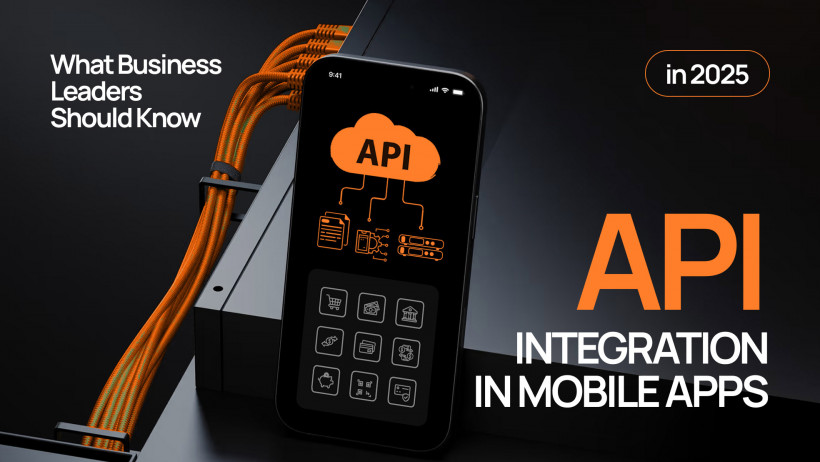APIs provide developers with a standardized way to access data and functionality from third-party systems and modules, eliminating the need to build such solutions from scratch. In a business context, this means that APIs enable businesses to quickly and cost-effectively automate repetitive tasks and processes. At the same time, ensuring secure and seamless data transfer requires a set of specific, sometimes non-obvious, practices on how to integrate APIs in apps. Actually, we’ll discuss them below.
What Is API Integration in Mobile Apps?
First, you should understand that API integration isn't simply a means of exchanging data between the client and server: it's essentially a bridge that facilitates payments, user authorization, push notifications, analytics, and more. That's why we often begin product development simultaneously with the design of API contracts – this saves us weeks on approvals and minimizes the risk of regression during releases.
If we look at the API integration process in mobile software in more detail, it's a full-fledged cycle: first, we create a contract, then proceed with server-side implementation, then connect client SDKs (most often Retrofit/OkHttp for Android, Alamofire/URLSession for iOS, and Apollo for GraphQL), and, finally, implement CI/CD and monitoring. We also optionally provide caching and offline data processing. Regarding documentation, we typically use OpenAPI for documentation, Postman/Insomnia for local validation, and Newman for CI to fully control API regression tests.
Ultimately, the choice of a technical stack for API integration is determined by the need for real-time data sync, the volume of data transferred, and the user requests’ specifics.
Common API Integration Use Cases
.jpg)
When discussing the most common API integration use cases, the following are especially worth mentioning:
- Authentication and user management. The implementation of these tasks depends on the type of software. For example, for native mobile apps, we resort to Authorization Code Flow with PKCE, short-lived access tokens, and refresh tokens for safe mobile backend integration. For ready-made solutions, Auth0 or AWS Cognito are better suited (they speed up the TTM), while for enterprise projects, Keycloak and sometimes even custom solutions are the best options. In other respects, our approach is the same and includes multi-factor authentication and security, forced refresh token changes (if suspicious activity is detected), monitoring login anomalies, and rapid session revocation.
- Payment processing. For this, we always strive to minimize PCI obligations, for example, by introducing card tokenization through Stripe or Braintree (while only the server interacts with the token itself). If integration with Apple Pay or Google Pay is required, the choice is much more obvious – we use native SDKs. We also always set up an additional payment gateway integration, an event log, and a notification system for failed payments.
- Social media sharing and login. Social media API integration and login sharing require careful consideration of privacy policies – this is why it's so important to use native SDKs, correctly introduce authorization code exchange on the server, and ensure fallback is implemented as local registration. Also, to avoid complaints from end users, we automate tests for token expiration and provider API failures.
- Push notifications and messaging. Implementing push notifications and messages requires connecting to a delivery provider (APNs for iOS and FCM for Android) and building a server layer with queues and retry logic. We also often have to develop opt-in/opt-out UX and define custom rules for using silent and/or payload notifications to ensure error handling in API calls.
If you'd like to implement at least one of these scenarios in your mobile app, email or call us, and we'll bring them to life quickly, securely, and cost-effectively.
Best Practices for API Integration

In general, at WEZOM, API integration is a comprehensive set of disciplines focused on an API-first approach. Below, we propose considering specific practices that will make your mobile product easy to maintain and scale:
- Secure authentication methods (OAuth, JWT). For mobile applications, we typically use Authorization Code Flow with PKCE and short-lived access tokens. We also follow a secure strategy involving refresh tokens, which are stored on the server and reclaimed in the event of suspicious activity.
- Handling API rate limits and errors. In all mobile solutions, we define client-side and server-side policies for rate limiting and retry logic from the outset. For example, on the client side, we implement exponential backoff with jitter and idempotency keys for secure retries; on the server side, we use a token bucket or sliding window throttling in the API gateway. Finally, for critical operations, we always use circuit breakers and bulkheads – this allows us to isolate external service failures and provide end users with a controlled fallback.
- Data caching strategies. Caching in our projects is multi-tiered. First comes the client tier for a snappy UX and offline mode, followed by edge or CDN to ensure static responses and fast processing of frequent requests. For the server tier, we typically use either Redis or Memcached – they provide efficient processing of hot data without compromising the database load. We also utilize HTTP mechanisms and the stale-while-revalidate pattern.
- Version control and backward compatibility. In the vast majority of mobile projects, we choose semantic contract versioning and an explicit deprecation policy. Our team also ensures backward compatibility, implements automated contract tests, and uses feature flags and canary releases.
Of course, this is far from a complete list of life hacks we use when working with mobile software – everything depends on the specifics of a particular project. So, if you'd like to discuss the possibilities of API integrations in more detail, please contact us personally.
Challenges and Risks in API Integration
In our practice, we regularly test the mobile applications we create against the OWASP API Security Top 10 checklist, and also perform automated contract validation and vulnerability scanning in CI. However, challenges and risks may still arise, and here's how we overcome them:
- Dependency on third-party service uptime. This is a common problem for many mobile applications, so to avoid it, we always design for graceful degradation, which includes caching, feature flags, circuit breakers, and fallback flows. For critical flows, multi-provider support, health checks, and synthetic monitoring of third-party endpoints come to the rescue.
- Data privacy and compliance. To overcome issues with user data, we initially exclude user information abuse and never store their personally identifiable data where tokens could be used. We also resort to data encryption both at rest and in transit, and conduct data access audits and deletion policies upon request. When working with sensitive data, our experts select certified storage and processes (for example, PCI for payment data and HIPAA for medical cases) and set up logging.
- Latency and performance considerations. Here, we apply several practices: edge caching, Redis caching (for hot requests), and HTTP/2 or HTTP/3. We can also optionally use gRPC and Protobuf for low latency, and, on the client side, local caching and a stale-while-revalidate approach. Sometimes, tracing and application monitoring tools like Datadog may be required – they allow us to measure response times.
If you want to easily overcome all these and many other API integration challenges in your mobile app, choose WEZOM.

How to Choose the Right APIs for Your App
Generally speaking, choosing the right API for a mobile application is not an easy task. Therefore, we start from formulating a value hypothesis and identifying which scenarios bring the greatest ROI to your business (and what data and features are needed to achieve this). This is followed by load modeling and formalizing requirements for latency, security, and regulatory compliance. All this generates sustainable insights for building prototypes and measuring the real cost of API integration.
In general, any API should be selected based on fit-for-purpose criteria, that is, determining whether it can solve the primary problem without redundant integration, how easy it is to test and monitor, and what risks it poses to the app itself.
By the way, when it comes to secondary third-party API integrations, we strive to minimize their TCO by optimizing caching and limiting monitoring. Also, we rank APIs suitable for your needs based on their value and potential risks. As for critical integrations, we request incident playbooks from vendors and test them using synthetic monitoring and load tests (optionally resorting to multi-regional and multi-provider scenarios, too, to ensure the ability to connect to backup providers in the event of a primary provider failure).
Ultimately, you should understand that the cost of API integration isn't just a subscription, and it also includes recurring fees for requests, the number of active users, and, of course, expenses needed for integration and support.
How WEZOM Supports API Integration Projects
If you choose to approach WEZOM for API integration mobile apps, you'll receive end-to-end support: from architecture selection to direct integration, launch of updated software, and its ongoing support. Specifically, we’ll:
- Prepare OpenAPI/GraphQL contracts;
- Conduct threat modeling;
- Integrate SAST/DAST and dependency scanning into the pipeline;
- Organize penetration testing and log auditing;
- Create SDKs for teams;
- Build contract and integration tests;
- Configure CI/CD and observability dashboards;
- Transfer runbooks and documentation to your in-house team.
As a result, you'll receive a working product, polished by our cross-functional team and ready for future upgrades (for example, via Kubernetes, autoscaling, and/or cloud service APIs). Combined with regular use of failover API testing tools and our time-proven API versioning best practices, you'll get predictable growth costs, easy support, and the ability to adapt the API to new business needs without costly downtime.
By the way, if you're interested in learning how the API integration stage was introduced into the mobile development process for a specific project, you can read more about it in this case study – here, the REST API vs GraphQL difference is explained.
Conclusion
As you can see, with a thoughtful approach, mobile app API integration in 2025 accelerates time-to-market (as it requires less manual development), reduces support costs (primarily through centralized error detection mechanisms and SLAs from their vendors), and, ultimately, opens up great opportunities for implementing new monetization models – for example, through paid integrations and partner ecosystems. Therefore, if you would like to obtain all these benefits in your mobile project, don’t waste a minute – contact us.

